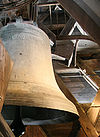- Clopin Trouillefou
-
Clopin Trouillefou The Hunchback of Notre-Dame character Created by Victor Hugo Information Gender Male Nationality French Clopin Trouillefou is a fictional character first created in the 1831 novel The Hunchback of Notre-Dame by French author Victor Hugo, and subsequently adapted.
Contents
In the novel
In the story, Clopin disrupts Pierre Gringoire's play, begging the audience for money. Later that night, Gringoire runs into him once again in the Court of Miracles, where Clopin is revealed not as a beggar, but as the King of Truands. He prepares to execute Gringoire for trespassing, until the beautiful Esmeralda agrees to marry him in order to save him.
Near the end of the novel, Clopin receives news of Esmeralda's upcoming execution for the framed murder of Captain Phoebus. In order to rescue her, he rounds all of the Truands to attack Notre Dame Cathedral where Esmeralda is protected by Quasimodo. In response to the assault, Quasimodo retaliates with stones, timber, and molten lead. Finally, the author notes that Clopin dies courageously during the attack.
Adaptations
In the Disney film
Clopin 
First appearance The Hunchback of Notre Dame (1996) Created by Michael Surrey Voiced by Paul Kandel Clopin is also present in the 1996 Disney adaptation The Hunchback of Notre Dame, in which he is a more jovial and less sinister gypsy than in the novel. However, he is much darker, in clothing and humor, when Quasimodo and Captain Phoebus arrive in the Court of Miracles, suggesting his personality during the day to have been something of a façade. However, he shows to have a gentle nature at the end of the film when he picks a little girl up and entertains her with a puppet resembling Judge Claude Frollo. He is voiced by Paul Kandel.
As well as narrating the whole film, Clopin introduces the film and begins the story with the song "The Bells of Notre Dame". He also sings "Topsy Turvy" about the traditional Parisian "Feast of Fools", held every year on January 6.
Clopin wears two main costumes during the film: a jester suit (seen to the right), which he wears at the Festival of Fools; he also wears a similar costume in the catacombs, but it is almost completely purple with no gold trim, no mask, and no bells. In "The Court of Miracles", he wears a lawyer outfit, a judges outfit, and an executioner's outfit for brief periods of time.
He appears in the film five times. The first appearance is when Clopin sings "The Bells of Notre Dame," which tells the tale of how Frollo killed Quasimodo's mother, but was stopped by the Archdeacon before he could kill Quasimodo by drowning him in a well.
The second appearance is at the Festival of Fools, where he sings "Topsy Turvy," a riveting dance number that explains that it is "the day we do the things that we deplore on the other three-hundred-and-sixty-four." It is also during this song that he crowns Quasimodo the "King of Fools."
His third appearance is much later in the film, at the Court of Miracles, which is where he and a large group of gypsies believe Quasimodo and Phoebus to be spies. They sing the song "The Court of Miracles" as Clopin puts Quasimodo and Phoebus on "trial" which includes a jury consisting of a puppet crafted in Clopin's likeness. He eventually finds them "totally innocent, which is the worst crime of all." He prepares to hang them, but Esmeralda arrives in time to stop him and tell the gypsies of their good intentions. Both Quasimodo and Phoebus inform the gypsy people to leave, saying that Frollo knows of their hideout, and they agree to do so. Unfortunately, Frollo arrives just in time to attack the Court of Miracles and Clopin is seen with his people struggling to break free from their bonds.
His fourth appearance is briefly during the climax of the film where Esmeralda is at the pyre before Notre Dame. When Quasimodo rescues Esmeralda, Phoebus breaks free and rouses the civilians into action, and Clopin is seen jumping out of one of the many cages that hold the gypsies freed by the civilians. Along with the civilians they attack Frollo's soldiers.
His fifth and final appearance is at the end, where he sings a reprise of "The Bells of Notre Dame" while entertaining one of the young children as the civilians finally accept Quasimodo into their society.
As the movie's narrator, Clopin has a great deal of knowledge about Quasimodo's past, seemingly more than Quasimodo himself. This suggests that to know the whole story, throughout Paris he must have many contacts.
Not only is Clopin the narrator in the story, but he is also the King of the Gypsies, who at the time were being rounded-up and murdered in an act of "purification" by Frollo.
Clopin also appeared in the straight-to-video sequel, The Hunchback of Notre Dame II, as the host for the Festival of Love, although he is no longer the narrator and plays a much smaller role.
External links
The Hunchback of Notre-Dame by Victor Hugo Characters 
Films Esmeralda (1905) • The Hunchback of Notre Dame (1911) • The Darling of Paris (1917) • Esmeralda (1922) • The Hunchback of Notre Dame (1923) • The Hunchback of Notre Dame (1939) • Notre Dame de Paris (1956) • The Hunchback of Notre Dame (1966) • The Hunchback of Notre Dame (1977) • The Hunchback of Notre Dame (1982) • The Hunchback of Notre Dame (1986) • The Hunchback of Notre Dame (1996) • The Hunchback (1997) • Quasimodo d'El Paris (1999) • The Hunchback of Notre Dame II (2002)Other adaptations Disney songs Music soundtrack • "The Bells of Notre Dame" • "Hellfire"Categories:- The Hunchback of Notre-Dame characters
- Fictional clowns
- Fictional singers
- Fictional dancers
- Fictional Gypsies
- Fictional jesters
- Fictional French people
- Fictional French people in literature
- Fictional characters introduced in 1831
Wikimedia Foundation. 2010.
